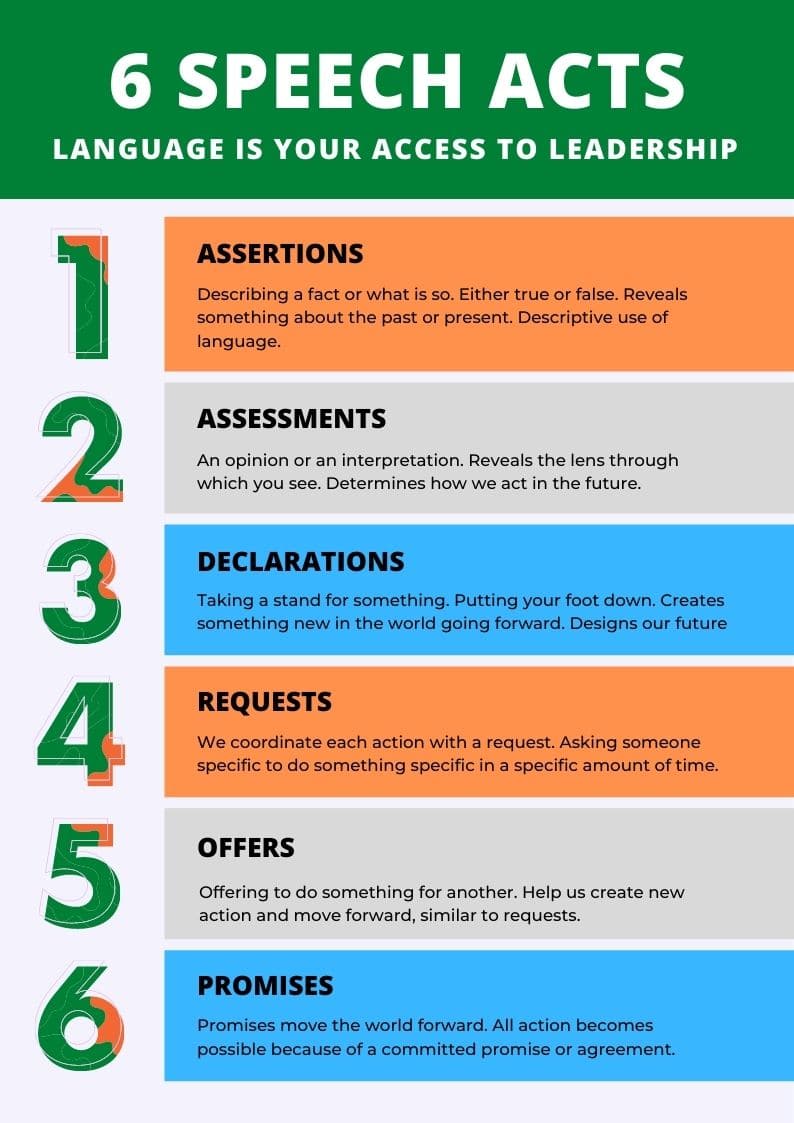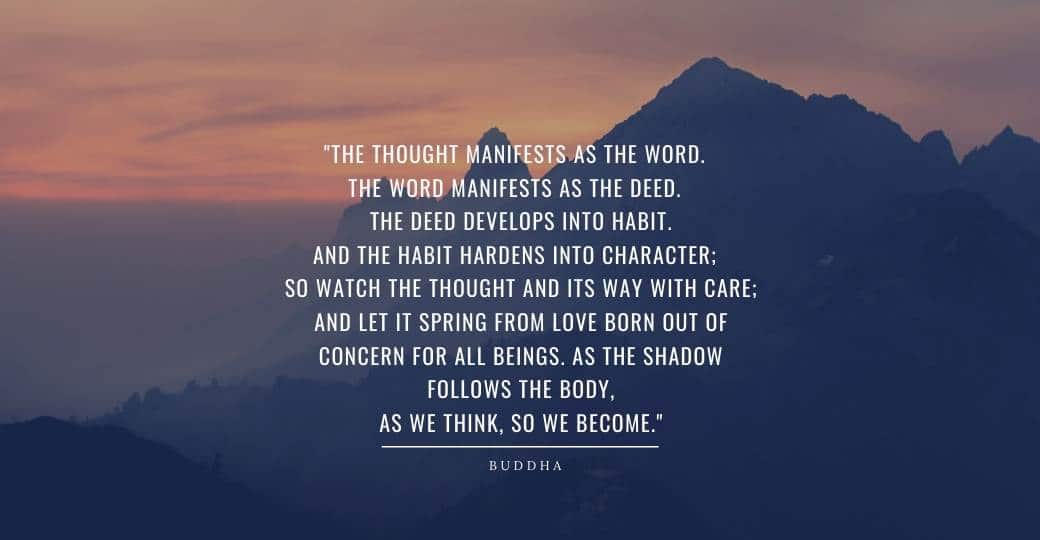Painters have a brush, digital artists use Photoshop, and musicians have their instruments to produce their results. Similarly, leaders have language – to produce results in their teams and organisations via having verbal communication.
Ask yourself- What do leaders do all day? If you observe leaders operating during a workday via a neutral third party like a camera, you will only observe them having conversations. Leaders have conversations all day. Leaders get paid to have effective conversations. As a corollary, leaders produce all results through prior conversations. The results that work for them, the results that are ineffective, and the results that are totally missing, all are the result of prior conversations.
We normally don’t see language as the most important leadership “resource”. This is because normally language’s role is seen as only to describe and communicate. However, language does not only describe and help us communicate. Language generates and creates our world. Our verbal conversations determine and create our experiences, our emotions, our possibilities, our problems, our opportunities, and so on. If you ponder over this fact, the implications are staggering.
If you don’t like how things are, change it! You’re not a tree. ― Jim Rohn
The speech act theory was introduced by J.L. Austin (How to Do Things With Words, 1962) and later developed by J.R. Searle. Most of what I have learned about language and words as your most powerful leadership tool comes from the work done by them and developed further by people like Fernando Flores, Rafael Echeverria, Julio Olalla, Robert Dunham, and others. This new model considers the way we use words and language as a type of action rather than just a medium to share and express information.
In this article, I attempt to show how language is not just a passive activity but instead a very powerful tool for shaping our future. Since leaders shape their future and of their teams and organisation, I found this directly applicable to producing results as a leader. I have used this view of language to produce highly effective teams – both in my role as a leader in several IT companies and also in my role as a leadership coach with my coachees.
One of the quickest ways to improve your way of being is to change the words you use, to others and to yourself. When I say words, it includes the spoken words and the unspoken thoughts too. Just by changing the words we use, we can release a lot of tension and create joy. Speak words that profit others, depict hope, courage, and inspiration and create positive images. Then notice the difference in how your surroundings and people react. This includes and goes much beyond what we normally understand as verbal and nonverbal communication.

The speech acts theory says that every conversation that we have involves the below 6 speech acts. We always use these speech acts, though we might not be aware of the distinctions between them. As human beings, we can not not use them. They are:
- Assertions,
- Assessments,
- Declarations,
- Requests,
- Offers and
- Promises
Assertions
Assertions are the facts and events which we can objectively identify in the world. This would be something a camera would observe – just the raw facts without adding any interpretations or judgements over it. For example – His height is 165 cm, He came to the meeting 15 minutes late, She is the CEO of XYZ Corporation are all facts that can be verified as true or false. However, he is tall (or short), he is reliable (or not), and she is a good (or bad) leader are not facts. They are the speech act that follows below – Assessments.
Assertions describe something about the past or the present, and it is where language is most descriptive. It is the job of a leader to separate assertions from assessments. Leaders are paid to make the distinction between the two so that they can trust their decisions and not get lost in action arising from ungrounded assessments.
Assessments
Assessments are opinions, judgements, or interpretations of assertions. They are never true or false, as different people can interpret the same event another way. However, they can be grounded or ungrounded, which means finding enough evidence and reasons to trust an assessment.
Assessments reveal something about the one making the assessment. It reveals the lens through which we see and observe the world. Since assessments are subjective, you can always find someone with the opposite assessment as yours. Our assessments directly impact the way we see the world and how we act or do not act in the future, and in that sense, it is a “generative” use of language and verbal communication.
Examples of assessments are – “He is not disciplined, I am a slow learner, and she is so clumsy”. It is normal to confuse assertions with assessments. This confusion causes not only personal suffering but can also hurt individual and team performance in organisations. Making grounded assessments are directly related to the amount of value any leader offers in an organisation. Knowing which assessments are not helpful, and then dropping them, is one of the characteristics of a sound leader.
“Things are as they are. Looking out into the universe at night, we make no comparisons between right and wrong stars, nor between well and badly arranged constellations.”
― Alan W. Watts
Declarations
Declarations are a powerful leadership move because we create the world we see through our declarations. While we are describing the world when using assertions, we create and form our own reality when we use declarations. Declarations help us design the future, and that makes them a powerful leadership move. The below are examples of some declarations:-
- You are guilty of the crime
- You are fired
- From now on, we will hire employees only after 5 rounds of interviews.
- All men and women will be judged by their character rather than the colour of their skin.
- We will put a man on the moon by the end of this decade.
“Whether you say you can, or say you can’t — either way, you are right!”
Think about the declarations you have consciously or subconsciously made in the past, and the impact it has had on your life? Think about a declaration which you can make which can transform your team or organisation? What is stopping you from making such a declaration?
Declarations are a powerful tool leaders use to create a new future and inspire people to take action towards realising that future. Leaders make declarations that will take them and their organisations where they want to go. Making powerful declarations might be uncomfortable and uneasy, but all leaders use the leverage of declarations to shift the current situation to where they want to take their teams and organisations.

Requests
Requests need no introduction. We make them every day – of ourselves and of others. Requests are how we get anything done in interpersonal relationships and communication. Every result you have today is a result of a request (or offer or promise) that you made previously. If you want to produce a result in your life that you currently desire, one question to ask yourself is – “What are the requests that I am not making to produce the result that I want?”
For example – “Can you help me?” is a very powerful request and yet so many leaders find it so difficult to make it because of the vulnerability it requires. Requests help us move forward. Every time we are stuck, the answer is in a request which you have not made yet.
A request creates a future that would not have happened otherwise. When you request your friend for a meeting, it creates a new future (the meeting) as soon as your friend says Yes. Requests propel future action. All of this may sound simple, but it is not trivial because while there is nothing new in making requests, so many of us are unaware of what makes a request effective or ineffective.
Effective requests have the below elements :
- A committed speaker – Are you serious when making the request?
- A committed listener – Is the person you are making the request to listening and committed?
- Conditions of satisfaction – What are the exact requirements for the successful fulfilment of the request? Or have you left it vague or open to interpretation?
- Time – As soon as possible, soon, urgently are not acceptable answers. Time has to be specific – like 9 am tomorrow, or by the end of day 20th September.
- Context – Why are you making the request? What is the context behind it? Have you shared it with the listener?
- How are you making the request? What is the mood and emotion behind the request? The same request when you are angry and when you are happy are two different requests, and will likely produce two different results.
Offers
Offers are similar to requests except that you offer to do something for the other person rather than requesting them to do something. Both requests and offers become a Promise when the other person says YES. For example – “Can I prepare you tea?”, “Do you want me to finish the rest of the work?”, and “I can attend that meeting instead of you if you would like me to?” are all offers.
Promises
We make a request or an offer with the intention of getting a declaration “YES” from the other person. When an offer or a request is accepted, it becomes a promise. We swim in a sea of promises every day. Promises are what makes the world operate the way it does. On the other hand, any breakdown in coordination is also a result of weak and ineffective promises.
Promises power all business organisations, all trade and purchases, and even simple actions like taking a vacation together involve a myriad of promises. Promises, when managed well, strengthen relationships, produce expected results, and can build a strong reputation. On the other hand, broken and mismanaged promises can lead to broken trust and relationships, breakdowns in results, and can destroy reputations.
When promises are broken, everybody involves pays a cost. The role of leadership involves making bold and trustworthy promises and also seeking reliable promises from your teams and peers. Our organisations and the world we live in can be seen as a network of promises, agreements, and commitments.
Conclusion
Language allows us to not just verbally communicate but also reference the past and imagine and coordinate action for the future. In a way, language is the way we make the past and the future actionable in the present. Without language, we would have no way to imagine a future, inspire a vision, manage commitments, and coordinate successes and failures along the way.
Seen this way, language and the words we use become the most powerful tool we use as leaders to create all results in our life. It is through language that we create trust and strong relationships. It is through language that we manage complex and complicated projects. It is through language that we inspire and motivate others. Through language, we make all our results meaningful to us and the people around us. If you are a leader, language is your most powerful tool as a leader.

Trackbacks/Pingbacks